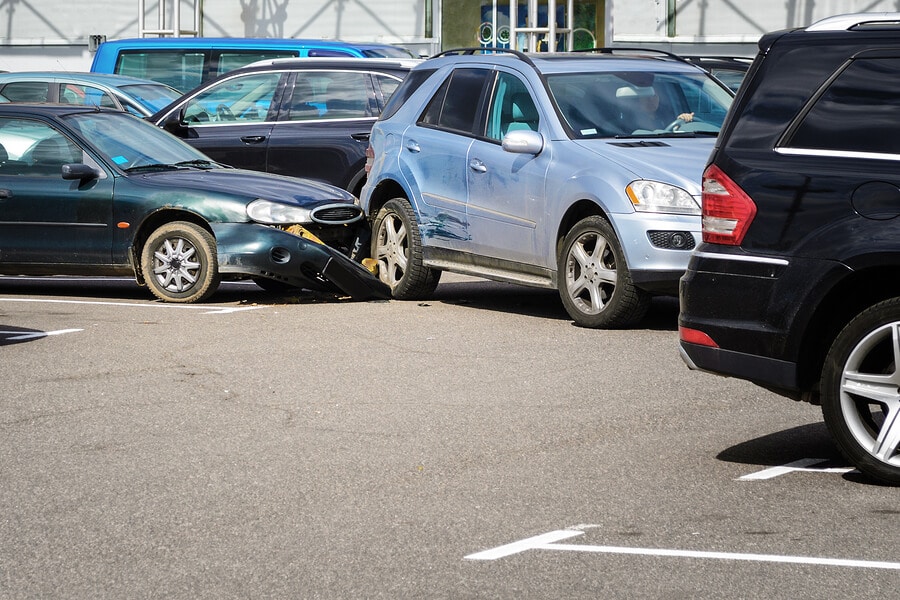Did you know that 1 in 5 car accidents occur in a parking lot?
Congested parking lots and places with dim lighting can make it harder for some drivers to pay attention to not only their own car but also other vehicles around them. Not to mention, traffic laws aren’t enforced in a parking lot, which often leads confusion and irresponsible driving.
Most accidents happen during the holidays, as more people are on the road during this time, and many of them end up drinking. So when the holiday season rolls around, you have to be extra careful where you park your car and how you do it.
But what do you do when you are involved in a parking lot accident?
In this article, we’ll explore what options you have to protect yourself legally. Read on to learn the steps you should take if you ever find yourself in a parking lot car crash.
What you should do if you’re at fault
- Surveillance cameras are everywhere in parking lots, so don’t drive away. If you’re in a hurry, leave a note, or you’ll likely end up dealing with the consequences of a hit and run.
- If you’re in a parking lot near a commercial center, try to contact the driver by going inside the store. You can speak to a representative who may allow you to make an announcement.
- Take a photo of the damages and call the police. If you skip this step, you may have to pay more in damages. There are cases where the victim causes more damage to their own car so they get more money out of you.
- Don’t act like you’re guilty and avoid apologizing. The surface of the parking lot, the lighting, and the design of the building can also be to blame for the crash. If you do start apologizing, it will imply guilt. Leave it to the insurance adjuster to determine who is to blame.
- Crashing into somebody’s car is not a crime, but leaving the scene of the accident is. Therefore, stay calm and keep in mind that if you’re insured, your insurance company will cover the damages anyway.
What you should do if you’re the victim
- Contact your insurance agent and send them a photo of the damages. A professional should be able to tell you what steps to take next.
- Contact the police if it’s an emergency, or use a non-emergency line if nobody is hurt. The local authorities will document the accident and help you get compensations faster.
- If the driver who caused the accident is still around, ask them for their contact information and name.
- Ask around if there’s a surveillance camera in the parking lot.
- Don’t accept any money or under-the-table deals from the driver who hit your car. Without a specialist, it’s hard to figure out the extent of the damages.
- Don’t avoid contacting your insurance company. If your rates do go up, speak with another insurance specialist to shop around for better rates. Here are a few of the things that can help you save money on car insurance.
Why and how to file a claim
The process for filing a claim for a parking lot accident is no different than doing so for any other type of accident. You need as much information as possible about the driver who hit you car, including their name and license plate number, the date and time of the accident, photos of the damages, and a police report.
Many drivers don’t like the idea of getting the police involved. But without a police report, you don’t have proof from authorities that the car crash happened.
In some cases, especially in big cities, the police won’t arrive on time. This can occur if more serious accidents happened at the same time in other parts of the city. But making that phone call, and taking notes and photos, is still crucial.
Fortunately, most insurance companies cover accidents that happen in parking lots. This brings me to my next point: many drivers beg the victim to make a deal with them and accept money in cash. Maybe they were under the influence, or maybe they don’t have an insurance.
Regardless of the situation, it’s not worth the risk of getting paid less for damages just to help someone who doesn’t respect the law and is potentially dangerous to other drivers. Always say no to offers like this, and if you fear your rates will go up, look for a new insurance specialist.
At Gebhart, you can get a free quote by giving us a call or texting us.
What happens when your car suffers major damage?
Seeing your car completely destroyed by a car accident isn’t easy most especially if it’s a parked car, but don’t panic. This is why insurance companies exist. They’re there to get you out of ugly situations.
Your insurance may be able to cover all of the damages done to your vehicle. Also, make sure you read the fine print when you get car insurance, as some policies can even provide you with enough money to buy a better car than the one destroyed in the car crash.


